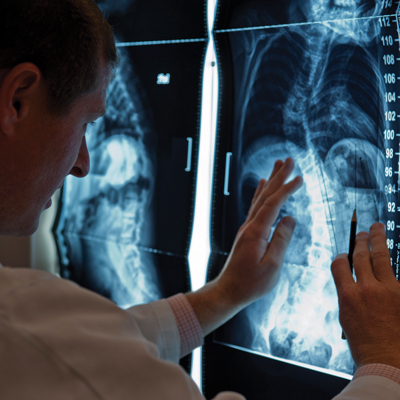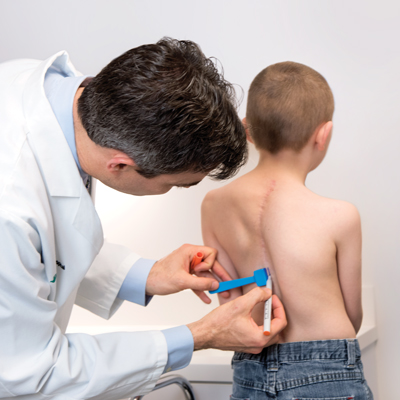Overview

Scoliosis is defined as an abnormal sideways curvature of the spine. About 2 to 3 percent of the U.S. population, or 7 million people, have this condition.
Scoliosis may be detected in infancy, childhood or adolescence. While this condition affects both girls and boys, girls are 10 times more likely than boys to need corrective surgery for it.
The thing to pay attention to is whether or not scoliosis progresses. Curves that are larger have a greater chance of progressing than smaller curves. However, even mild curvatures may worsen as a child’s spine grows. During this time of growth, the spine should be followed by a physician.
Progression can lead to severe consequences in adulthood, including lung and heart problems and potential back pain.
That’s why it is important to:
- detect scoliosis as early as possible
- monitor its progress
- intervene when necessary
Types
There are three types of childhood scoliosis:
- Idiopathic scoliosis — Idiopathic scoliosis represents 80 percent of all scoliosis cases. It usually develops during adolescence, between ages 10 and 16. Scoliosis that develops earlier can be defined as infantile (0-3 years) or juvenile (4-10 years). The younger a scoliosis curve develops, the higher the chance that it progresses or worsens. Idiopathic means “of unknown cause” and scientists have not yet unraveled why scoliosis develops. But because idiopathic scoliosis runs in families, it has a genetic basis.
- Congenital scoliosis — Congenital scoliosis is a fairly rare bone abnormality detected at birth. The vertebral (spine) bones do not form normally and this can lead to scoliosis. Very often, it accompanies other birth defects, such as heart or kidney problems.
- Neuromuscular scoliosis — Neuromuscular scoliosis is caused by abnormalities in muscles and nerves that support the spine. Thus, patients with muscular dystrophy, spina bifida and cerebral palsy are susceptible. Neuromuscular scoliosis can become quite severe
Scoliosis looks different in different people:
- It may be mild.
- It may be severe.
- It may involve a single, short “C” curve.
- It may involve a long, double or triple “S” curve.
Progression (worsening)
Idiopathic scoliosis may or may not progress. The two most important factors influencing progression are the size of the curve and the skeletal growth remaining for the child. The younger a child is and the larger the curvature, the more likely the deformity will worsen. Fortunately, intervening at the right time can prevent complications and ease symptoms.
Identifying Scoliosis Early

Early detection and monitoring are very important to keep spinal curvatures from progressing. Beginning at age 8 or 9, children are screened for scoliosis at annual checkups with their pediatricians.
The pediatrician will examine your child for a difference in shoulder height, an uneven waistline or a prominence on one side of the back while standing.Then your child will be asked to do a “forward bend test,” bending down to touch his or her toes. This is the best way for the pediatrician to see a prominence on one side of the back.
Any child who has an abnormal forward bend test result should be referred to a pediatric orthopaedic specialist, or expert on skeletal growth in children and adolescents. The pediatric orthopaedic specialist will perform an examination and order X-rays of the spine. These will determine the degree of spinal curvature as well as your child’s skeletal maturity.
Typically, children with scoliosis need to visit the pediatric orthopaedic specialist every six months. They will be examined and will have X-rays taken to check how much or how little the curve is progressing.
The pediatric orthopaedic doctor who monitors your child will let you know when and if any intervention might be necessary. If the curve remains small, no treatment other than continued observation is needed
Recovery at Home

Spinal fusions are major surgery. So your child may not feel like himself or herself for three to four weeks. By four to six weeks, your child will be ready to return to school.
Most children do not need bracing during recovery. To allow the bone to heal, however, your child should avoid bending, twisting and lifting anything over 10 pounds. In six months’ time, your child can start stretching and return to sports.
At six months, they are free to resume all normal activities — even riding roller coasters, water skiing and mogul skiing. However, heavy contact sports such as football and rugby are not recommended at any time after spinal fusion.
Fusion Surgery
Timing of surgery for large curves
For adolescents, surgery is scheduled when thoracic (chest) curves reach 45 to 50 degrees or when lumbar (waist) curves reach 40 to 45 degrees despite bracing. Skeletal growth must be complete or nearly complete.
For young children, surgery does not involve fusing the spine. Instead, a “growing rod” is surgically attached to the spine to stabilize it. This allows the chest and spine to grow almost to maturity, when the spine is ready for permanent fusion.
Fusion surgery
Fusion surgery for scoliosis involves joining together the bones, or vertebrae, of affected segments of the spine to realign it and halt curve progression. Surgeons today fuse the minimum number of vertebrae needed to correct a curve, and almost always use a “posterior approach.”
In posterior fusion, the spinal column is accessed from the back, and screws are placed into the affected vertebrae. A short rod is then inserted into slots along the top of the screws. The surgeon gently moves the rods to correct the spine’s alignment, then bolts the hardware in place. A bone graft is placed on top of the treated area to encourage bone healing. The end result: a much straighter spine and a sturdy correction.
Because scoliosis presents in different patterns and degrees, other surgical approaches are available as well.
| Other Surgical Approaches for Treating Scoliosis | |
|---|---|
| Approach | Advantage |
| Posterior (through the back) | This approach, the most common, avoids the slight potential risks of lung damage and achieves an excellent result. |
| Anterior (through the side) | This approach is rarely used but may assist surgeons in repositioning the spine when curves are complex. |
| Combined anterior-posterior approach (through the front and side) | The combined approach is rarely used, but may assist with bone healing in complex cases. |
| Thoracoscopic approach (minimally invasive) | This approach is rarely used, but inserting a “scope” through the chest may help surgeons to loosen very large, complex curves. It causes less scarring than anterior fusion, but typically posterior fusion is still needed afterward. |
Your Child's Hospital Stay
Most hospital stays for scoliosis fusions are three days, but some may last up to a week. Your child will spend the first night in the intensive care unit and will then move to a hospital floor. Physical therapy will begin the day after surgery, when your child will be getting out of bed on his or her own.
Thanks to early therapy, your child will be able walk through the hospital doors at discharge. At home, he or she will be able to walk around the house, climb the stairs and go outside.
Managing Scoliosis
Treatments for scoliosis have advanced dramatically in the last 10 years. There are four options:
- Observation — Children who have idiopathic scoliosis and mild (10-to-25- degree) curves only need to be monitored by pediatric orthopaedic specialists. They will be observed most carefully during their growth spurt in puberty, when most curvatures are likely to worsen.
- Bracing the spine — Children with further growth remaining and curves of 25 to 45 degrees may benefit from wearing a brace, or orthosis. The brace applies gentle pressure to the trunk and pelvis to keep the spine as straight as possible while the child grows.
Most braces are now custom-made, using plastic with padding, and are molded to conform to the child’s trunk (the large metal “Milwaukee” braces are a rare sight today). Some children with idiopathic scoliosis only need to wear their brace at night.
Every four to six months, X-rays are done to re-measure the child’s curve. The doctor will halt bracing when the child’s skeletal growth is complete, at which point bracing no longer helps.
For some children, bracing is a temporary measure until surgery can be performed. For children with very large curves (more than 45 degrees), bracing is not helpful at all.
- Traction — In rare cases, children with severe spinal curvatures may benefit from a period of “halo” traction. This usually involves a hospital stay. A ring is attached to the skull and increasing weights are gradually applied to it as the patient remains mobile. This helps to loosen the spine and stretch the muscles, arteries and nerves, resulting in better alignment and safer surgery. At advanced centers such as Cleveland Clinic, traction can sometimes be applied to young patients in wheelchairs and walkers so that they remain mobile.
- Surgery: Repositioning and fusing the spine — Surgery is considered for only a fraction of scoliosis patients. It is important when bracing can no longer hold the scoliosis in check or when curves are too large for bracing. The timing of surgery varies, depending upon the degree and type of curvature.
| Bracing Recommendation for Scoliosis | |
|---|---|
| Type of scoliosis | Bracing recommendations |
| Idiopathic scoliosis | Bracing may be helpful as the spine grows to prevent curves from worsening |
| Neuromuscular scoliosis | Bracing can improve sitting posture and trunk stability when children are in wheelchairs |
| Congenital scoliosis | Bracing is rarely helpful for these children, who tend to have large curves |
Managing Pain & Other Needs
Cleveland Clinic Children’s and similar centers have pediatric anesthesiologists on staff. They are adept at managing children’s anesthesia, and will provide general anesthesia for spine surgery. Large centers like ours also have a neurological team to monitor spinal cord function minute-by-minute during the entire procedure.
After surgery, pediatric anesthesiologists make sure that each child’s pain is well-controlled. They may provide epidural anesthesia or prescribe patientcontrolled analgesia (PCA). Patients using PCA can “pump” safe doses of pain medicine through an intravenous line when they need it.
FAQ's
Our experts provide answers to some of the most common concerns they hear from children and teenagers:
Why did I get scoliosis?
You did not do anything wrong that caused scoliosis. Scoliosis is a genetic condition, but scientists do not yet understand the exact cause. It can be congenital (bones formed abnormally) or neurological (from a disorder like cerebral palsy).
Can you predict if my scoliosis is going to get worse?
Not all cases of scoliosis progress (get worse). The younger you are and the larger your curvature, the more likely the scoliosis will get worse.
What position do I need to sleep in?
You can sleep in any position that is comfortable.
Can I still exercise?
Definitely. Exercise is important to staying healthy. Your activities will not make your scoliosis worse.
Who has to wear a brace?
Your doctor may recommend you wear a brace temporarily to keep your curve from getting worse during a growth spurt. The braces are lightweight and usually only need to be worn at night.
Will the brace make my scoliosis better?
Some studies show that bracing will keep some curves from getting bigger and requiring surgery. But some curves will go back to normal once the brace is no longer worn. More research is needed to figure out how and when bracing is the best option.
How do I know if I need surgery?
Not everyone needs surgery for scoliosis. Your doctor may recommend it if bracing can’t hold your scoliosis in check anymore, or if your curve is too large for bracing. He or she will discuss the best timing for surgery with you and your family.
How should I choose a surgeon?
We know it can be a major decision to pick a surgeon for your care, especially if you have to travel. Talk to your primary care physician and orthopaedic specialist, and carefully research any potential surgeons online. You will want to pick a doctor who is experienced and performs a large number of pediatric and adolescent scoliosis surgeries each year. Consider their training and the hospital’s outcomes.
How soon after surgery can I walk again?
You can begin walking again as soon as you are comfortable. This is typically the first day after surgery.
How long will I be in the hospital?
Three days is the average. But it may be a bit more or less, depending upon how you are doing.
How much school will I miss?
Up to six weeks, but some children and adolescents are ready to return to the classroom in as little as three weeks.
After surgery, is there anything I won’t be able to do?
Once you leave the hospital, you can return to your normal activities at home. You should avoid bending, lifting more than 10 pounds and twisting your torso for the first six months. Your doctor may clear you to return to sports at about six months.
Will I need more surgery in the future?
Additional surgeries are not often needed. Follow up with your surgeon for up to five years after your surgery to make certain your spine heals correctly.
Myths

Busting Scoliosis Myths
Myth: You can tell someone has scoliosis by their hump.
Fact: Scoliosis always produces a hump on the ribs, but the size of the hump depends on how much the spine curves and rotates. The spine tends to rotate toward the direction to which it curves. The ribs on the same side of the curve then get pushed backward. A large curve will push the ribs out dramatically on one side of the chest. A small curve may be barely visible. In fact, some people live their entire lives without realizing that they have mild scoliosis. Being aware of scoliosis means it is important to monitor progression.
Myth: Alternative therapy can cure scoliosis.
Fact: Acupuncture, chiropractic therapy, physical therapy and electrical stimulation have been touted as alternative therapies for scoliosis, but they do not affect the progression of the curve. Curves that progress beyond 45 to 50 degrees should be treated to avoid severe consequences. Surgery is the only way to permanently realign the spine; even bracing can only halt curve progression at best. That said, alternative therapies may relieve some patients’ discomfort. And stretching and staying fit are always important for overall health and well-being.
Myth: You can’t bend over after a spinal fusion.
Fact: Not only is it possible to bend over after a spinal fusion — some patients are even able to touch their toes and get into a tuck position. Contrary to popular opinion, we don’t just bend from the waist. We bend from the hips, which are unaffected by surgery. Fused areas of the spine will have less mobility, but surgery will not greatly affect your overall mobility
Appointments
Contacting Cleveland Clinic
Ready to schedule an appointment? To make an appointment with a scoliosis specialist at Cleveland Clinic, call 216.444.2606 or 866.275.7496
Virtual Visits
Whether you're a new or existing patient, you can get an initial evaluation or follow-up care from a pediatric scoliosis specialist using your phone, tablet or computer. This means there's no travel or parking, less waiting and significant time savings. Call 216.636.5860 to schedule a virtual visit for you or a loved one and get details on cost and set-up instructions.
Virtual Second Opinion
If you cannot travel to Cleveland Clinic, help is available. You can connect with Cleveland Clinic specialists from any location in the world via a phone, tablet, or computer, eliminating the burden of travel time and other obstacles. If you’re facing a significant medical condition or treatment such as surgery, this program provides virtual access to a Cleveland Clinic physician who will review the diagnosis and treatment plan. Following a comprehensive evaluation of medical records and labs, you’ll receive an educational second opinion from an expert in their medical condition covering diagnosis, treatment options or alternatives as well as recommendations regarding future therapeutic considerations. You’ll also have the unique opportunity to speak with the physician expert directly to address questions or concerns.
Patient Services
MyChart
Cleveland Clinic’s MyChart® is a secure, online tool that connects you to portions of your electronic medical record from the privacy of your home. Utilize this free service to manage your healthcare at any time, day or night. With MyChart you can view test results, renew prescriptions, request appointments and more. You can also manage the healthcare of your loved ones with MyChart • Caregiver.

